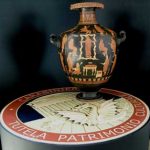Gianfranco Becchina
Author: Neil Brodie
Last Modified: 20 Aug 2012

Gianfranco Becchina is an Italian antiquities dealer who has been convicted in Italy of illegally dealing in antiquities.
Becchina started dealing in antiquities from his premises in Basel, Switzerland in the 1970s, and is said to have sold material to major museums including the Ashmolean, the Louvre, the Boston Museum of Fine Arts, the Metropolitan Museum, the Princeton University Art Museum, the Toledo Museum of Art and the J. Paul Getty Museum (Isman 2011b: 50). It is also claimed that he was a major source of material for collector George Ortiz (allegedly selling him entire tomb groups from southern Italy in 1986), and sold material to collectors Leon Levy and Shelby White, the Merrin Gallery in New York, Japanese antiquities dealer Noriyoshi Horiuchi, and ‘fragments’ to Dietrich von Bothmer of the Metropolitan Museum of Art (Isman 2011b: 50). He had links with fellow dealers Mario Bruno and Elie Borowsky (Isman 2011b: 52; Watson and Todeschini 2007: 294), and sold material through Sotheby’s and Christie’s auction houses in London, sometimes using assumed names, such as Anna Spinello (the married name of his sister) (Watson and Todeschini 2007: 293-4).
In 1994, the Carabinieri identified among photographs discovered in the wreckage of Pasqale Camera’s car (who had been under investigation for illegal dealing in antiquities) one of a Paestan red-figure krater attributed to Asteas, which in 1998 was found to be in the J. Paul Getty Museum (81.AE.78). The Getty had acquired the piece from Becchina, arousing suspicions that Becchina too might be involved in the illegal trade (Watson and Todeschini 2007: 290). Soon after, the Carabinieri recognized his central place on the ‘organigram’, where he was shown as head of a cordata and a major supplier of Robert Hecht, and a receiver of material from Raffaele Monticelli of Taranto, who was sentenced to four years in prison in 2002 (Isman 2011b: 50; Watson and Todeschini 2007: 292). By then, Becchina had moved back to his hometown of Castelvetrano in Sicily, leaving his wife Rosie in Basel to oversee his business there. Despite his absence, in May 2002 the Carabinieri, in collaboration with Swiss police, raided his premises in Basel, which included the gallery Antike Kunst Palladion, two storage facilities inside Basel Freeport, and one storage facility outside the Freeport (Watson and Todeschini 2007: 292). A fourth storage facility operated by Becchina was discovered and raided in 2005 (Watson and Todeschini 2007: 293). The 2002 raids alone resulted in the recovery of 6,315 artefacts in various stages of restoration, 8,000 photographs of artefacts, and 13,000 documents (Isman 2011: 50; Watson and Todeschini 2007: 292). In February 2011, Becchina was convicted in Rome of illegally dealing in antiquities. He appealed against the conviction ( ICE 2012b; Isman 2011a: 50).
The J. Paul Getty Museum and the Toledo Museum of Art have both returned material to Italy that was acquired from Becchina and subsequently shown to have been illegally exported. In April 2012, US Immigration and Customs Enforcement returned two ceramic vessels and a marble janiform head seized from Christie’s New York auction house that were associated with the investigation of Becchina (ICE 2012a). The artefacts had been imported into the United States in violation of a bilateral agreement reached between Italy and the United States in 2001 (renewed in 2006 and 2011) under the 1983 Convention on Cultural Property Implementation Act. The two vessels (Attic red-figured situla and pelike) had been consigned for sale by an unnamed Beverly Hills Gallery.
References
ICE (2012a), ‘ICE returns stolen and looted art and antiquities to Italy’, press release, 26 April (Washington DC: Immigration and Customs Enforcement). http://m.ice.gov/news/releases/1204/120426washingtondc.htm?f=m, accessed 15 August 2012.
ICE (2012b), ‘Agreement paves way for artifact’s return to Italy’, press release, 18 June (Washington DC: US Immigration and Customs Enforcement). http://www.ice.gov/news/releases/1206/120618cleveland.htm, accessed 15 August 2012.
Isman, Fabio (2011a), ‘Guilty verdict for dealer who sold the Getty Museum its dubious $10m kouros’, Art Newspaper, (222), 9.
Isman, Fabio (2011b), ‘The masterpiece sold for $1000 and a suckling pig’, Art Newspaper, (225), 50-52.
Watson Peter, and Todeschini, Cecilia (2007), The Medici Conspiracy (New York: Public Affairs).
















